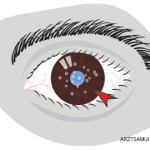As soon as pediatric patients are diagnosed with juvenile idiopathic arthritis (JIA), they should also be screened for uveitis, says ophthalmologist Gary Holland, MD. Otherwise, the University of California, Los Angeles, provider says, “Kids who are diagnosed with JIA may not come to an ophthalmologist until they have vision-limiting complications.”
Uveitis is the most common extra-articular manifestation of JIA, and it is always chronic once it develops. Pediatric patients with uncontrolled chronic uveitis are at increased risk for cataracts and glaucoma, synechiae and vision loss. Until recently, recommendations for screening, monitoring and treating JIA patients were limited.
A First for the ACR/AF
On April 25, pediatric rheumatologist Sheila Angeles-Han, MD, MSc, and colleagues published the most comprehensive guideline for JIA-associated uveitis to date, containing 19 recommendations.1,2 The guideline appears in both Arthritis & Rheumatology and Arthritis Care & Research and is intended to aid clinical care for JIA patients at risk of, or already diagnosed with, uveitis.
“From a uveitis standpoint, this is the first guideline from the ACR and the Arthritis Foundation [AF],” says Dr. Angeles-Han, an associate professor at Cincinnati Children’s Hospital Medical Center and the University of Cincinnati. “There have been guidelines [published by others that] focused on treatment of pediatric uveitis, and there is a clinical report from the American Academy of Pediatrics that addresses ophthalmic screening in children with JIA, but there are not as many focused on ophthalmic monitoring, or on escalation and tapering of treatment in children with JIA-associated uveitis.”
The new guideline recommends treatment with methotrexate and the monoclonal tumor necrosis factor inhibitors (TNFi’s), adalimumab and infliximab, for management of uveitis in JIA patients when systemic treatment is warranted. The addition of biologic and non-biologic drugs reduces children’s risk for vision loss. Although the guideline calls for topical glucocorticoid use as an initial treatment to control uveitis-associated inflammation, it also recommends limiting pediatric exposure to glucocorticoids due to the potential for ocular toxicity.
“Often, the ophthalmologist is going to see the patient more often than the rheumatologist or pediatrician, so it’s important they are aware of what the medication options are and can counsel patients who need to know what to expect,” says Dr. Holland, who helped create the new guideline. “I think it’s important, if they’re going to be monitoring the patient, to have this body of information available.”
The Recommendation Process
The recommendations were generated through a comprehensive process that involved rheumatologists, ophthalmologists with experience with uveitis, patient and family representatives, and methodology experts.


